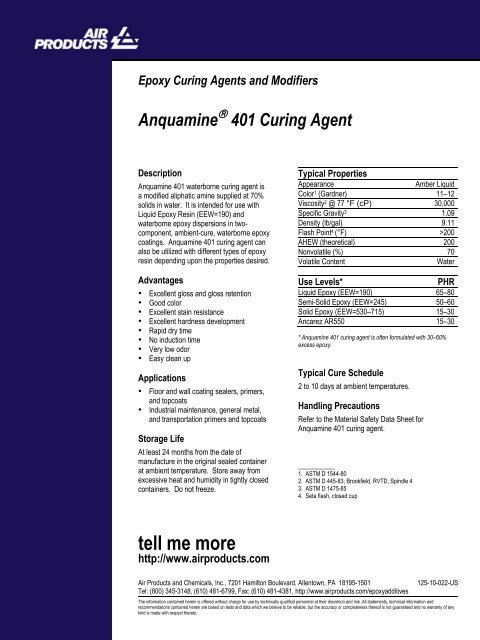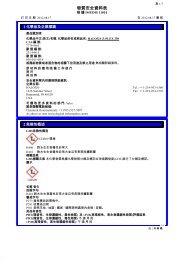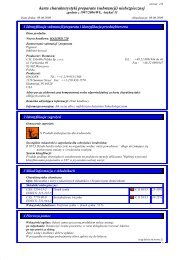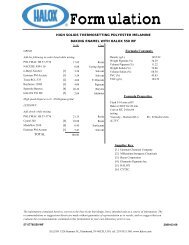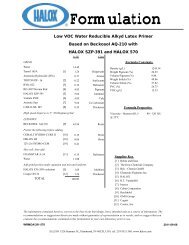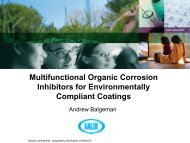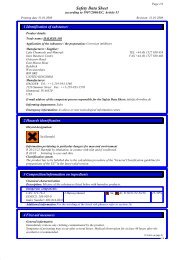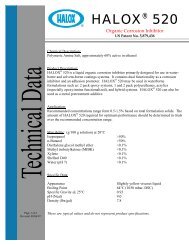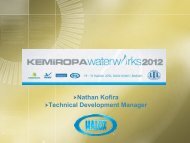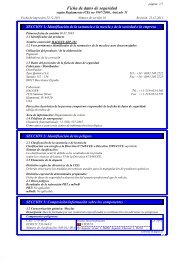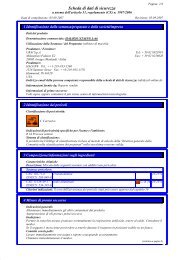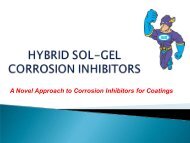Epoxy Curing Agents and Modifiers - Halox
Epoxy Curing Agents and Modifiers - Halox
Epoxy Curing Agents and Modifiers - Halox
Create successful ePaper yourself
Turn your PDF publications into a flip-book with our unique Google optimized e-Paper software.
<strong>Epoxy</strong> <strong>Curing</strong> <strong>Agents</strong> <strong>and</strong> <strong>Modifiers</strong><br />
Anquamine ® 401 <strong>Curing</strong> Agent<br />
Description<br />
Anquamine 401 waterborne curing agent is<br />
a modified aliphatic amine supplied at 70%<br />
solids in water. It is intended for use with<br />
Liquid <strong>Epoxy</strong> Resin (EEW=190) <strong>and</strong><br />
waterborne epoxy dispersions in twocomponent,<br />
ambient-cure, waterborne epoxy<br />
coatings. Anquamine 401 curing agent can<br />
also be utilized with different types of epoxy<br />
resin depending upon the properties desired.<br />
Advantages<br />
• Excellent gloss <strong>and</strong> gloss retention<br />
• Good color<br />
• Excellent stain resistance<br />
• Excellent hardness development<br />
• Rapid dry time<br />
• No induction time<br />
• Very low odor<br />
• Easy clean up<br />
Applications<br />
• Floor <strong>and</strong> wall coating sealers, primers,<br />
<strong>and</strong> topcoats<br />
• Industrial maintenance, general metal,<br />
<strong>and</strong> transportation primers <strong>and</strong> topcoats<br />
Storage Life<br />
At least 24 months from the date of<br />
manufacture in the original sealed container<br />
at ambient temperature. Store away from<br />
excessive heat <strong>and</strong> humidity in tightly closed<br />
containers. Do not freeze.<br />
Typical Properties<br />
Appearance<br />
Amber Liquid<br />
Color 1 (Gardner) 11–12<br />
Viscosity 2 @ 77 °F (cP) 30,000<br />
Specific Gravity 3 1.09<br />
Density (lb/gal) 9.11<br />
Flash Point 4 (°F) >200<br />
AHEW (theoretical) 200<br />
Nonvolatile (%) 70<br />
Volatile Content<br />
Water<br />
Use Levels*<br />
PHR<br />
Liquid <strong>Epoxy</strong> (EEW=190) 65–80<br />
Semi-Solid <strong>Epoxy</strong> (EEW=245) 50–60<br />
Solid <strong>Epoxy</strong> (EEW=530–715) 15–30<br />
Ancarez AR550 15–30<br />
* Anquamine 401 curing agent is often formulated with 30–60%<br />
excess epoxy.<br />
Typical Cure Schedule<br />
2 to 10 days at ambient temperatures.<br />
H<strong>and</strong>ling Precautions<br />
Refer to the Material Safety Data Sheet for<br />
Anquamine 401 curing agent.<br />
__________<br />
1. ASTM D 1544-80<br />
2. ASTM D 445-83, Brookfield, RVTD, Spindle 4<br />
3. ASTM D 1475-85<br />
4. Seta flash, closed cup<br />
tell me more<br />
http://www.airproducts.com<br />
Air Products <strong>and</strong> Chemicals, Inc., 7201 Hamilton Boulevard, Allentown, PA 18195-1501<br />
Tel: (800) 345-3148, (610) 481-6799, Fax: (610) 481-4381, http://www.airproducts.com/epoxyadditives<br />
125-10-022-US<br />
The information contained herein is offered without charge for use by technically qualified personnel at their discretion <strong>and</strong> risk. All statements, technical information <strong>and</strong><br />
recommendations contained herein are based on tests <strong>and</strong> data which we believe to be reliable, but the accuracy or completeness thereof is not guaranteed <strong>and</strong> no warranty of any<br />
kind is made with respect thereto.
Supplementary Information<br />
Anquamine ® 401 is designed for use with solid epoxy resin<br />
dispersions, liquid epoxy resin dispersions or with liquid<br />
epoxy resin. As illustrated below, several different epoxy<br />
resin dispersions can be used depending on the properties<br />
desired <strong>and</strong> the end-use application.<br />
Formulating Guidelines<br />
Anquamine ® 401 curing agent can be utilized with a variety<br />
of solid epoxy resin dispersions to produce corrosion<br />
resistant primers; high gloss enamels; concrete primer <strong>and</strong><br />
concrete paint for a variety of end user requirements. For<br />
development of optimum coating performance, the following<br />
formulation guidelines should be employed whenever<br />
possible.<br />
Stoichiometry<br />
Using an excess of epoxy resin is recommended in order to<br />
provide the balance of properties—maximum hydrophobicity<br />
accompanied by hardness <strong>and</strong> solvent resistance—which<br />
are the desired properties for primers <strong>and</strong> topcoats. If<br />
increased chemical resistance is required, reducing the level<br />
of excess epoxy resin is recommended. However this is<br />
likely to have an adverse effect on the water resistance of<br />
the coatings. Using a range of 60-90% excess epoxy is<br />
recommended for maximum corrosion resistance. Table 1<br />
below summarizes the positive influences of changing the<br />
stoichiometric ratio of curing agent <strong>and</strong> epoxy resin.<br />
Table 1<br />
Positive Influences of Changing the Stoichiometry<br />
Increase in <strong>Epoxy</strong> Resin<br />
Pot Life<br />
Salt Fog Resistance<br />
Humidity Resistance<br />
Water Resistance<br />
Alkali Resistance<br />
Acid Resistance<br />
Increase in <strong>Curing</strong> Agent<br />
Dry Speed<br />
Stain Resistance<br />
Solvent Resistance<br />
Higher Gloss<br />
Flexibility<br />
Abrasion Resistance<br />
Coalescing <strong>Agents</strong><br />
The use of coalescing agents is critical for optimum coating<br />
compatibility <strong>and</strong> film formation under a wide range of cure<br />
conditions <strong>and</strong> greatly impacts the aesthetic <strong>and</strong><br />
performance parameters of the coating. A combination of<br />
hydrophobic <strong>and</strong> hydrophilic solvents is typically<br />
recommended to assist in keeping the film open longer <strong>and</strong><br />
promoting water release. Recommendations for hydrophobic<br />
coalescing agents, which remain in the film <strong>and</strong> aid, flow, air<br />
release <strong>and</strong> open time are benzyl alcohol, ethylene glycol<br />
phenyl ether (EPh) <strong>and</strong> propylene glycol phenyl ether (PPh).<br />
For hydrophilic agents which promote water release from<br />
the film, PM solvent, ethylene glycol propyl ether (EP) <strong>and</strong><br />
propylene glycol propyl ether (PnP) are recommended.<br />
Typical hydrophobic solvent levels are 3% based on system<br />
resin solids.<br />
Pigments <strong>and</strong> Pigment Dispersion<br />
Anquamine 401 is an excellent pigment dispersant. Its<br />
excellent inherent pigment wetting <strong>and</strong> its high dilutability<br />
make it an ideal vehicle for pigmentation. If Anquamine 401<br />
is pigmented it is recommended that co-solvents are added<br />
to the curing agent prior to addition of extra water to aid<br />
viscosity reduction. <strong>Epoxy</strong> resin dispersions may also be<br />
pigmented, offering good formulating latitude. During the<br />
pigmentation process, system stability <strong>and</strong> ease of mixing<br />
pigmented resin <strong>and</strong> curing agent components are greatly<br />
enhanced by incorporation of a pigment wetting agent. The<br />
optimum level is dependent upon the PVC <strong>and</strong> the oil<br />
absorption of the pigments used in the paint formulation.<br />
Suitable wetting agents include Disperbyk 190 <strong>and</strong> Surfynol<br />
CT-111. The recommended addition level is in the 1–3%<br />
range based on total pigment weight. Typical PVC levels for<br />
the primers <strong>and</strong> gloss enamels are 35% <strong>and</strong> 15–20%<br />
respectively.<br />
Flash Rust<br />
Water-based primers may present flash-rust when applied<br />
over s<strong>and</strong>blasted steel, to eliminate this phenomenon we<br />
recommend small additions of flash-rust inhibitors <strong>and</strong><br />
excellent results were obtained adding a 10% aqueous<br />
solution of sodium nitrite (NaNO2) to the Part B (curing<br />
agent) side in the amount of 2 pounds of solution per 100<br />
gallons of paint (or around 1.2% by weight).<br />
Mixing <strong>and</strong> Application<br />
Thoroughly mix the A <strong>and</strong> B side components for 1–2<br />
minutes until a uniform consistency is achieved. For highgloss<br />
finishes, no induction time is needed. However, for<br />
maximum humidity <strong>and</strong> corrosion resistance, allow the<br />
mixed paint to induct for 15–30 minutes.<br />
For conventional spray, the mixed paint can be reduced to<br />
application viscosity with water.<br />
Good air flow across freshly painted areas will assist in<br />
water evaporation <strong>and</strong> improve dry speed.<br />
Typical pot life is 3–6 hours. In gloss enamels, end of pot life<br />
is signaled by a visible loss of gloss in the dried film. Paint<br />
remains fluid beyond the pot life but loses coalescence <strong>and</strong><br />
should be discarded. Do not mix expired paint with fresh<br />
paint.<br />
Clean Up<br />
Application tools can be cleaned with warm soap <strong>and</strong> water.<br />
Corrosion Resistant Primer Formulations<br />
Preliminary starting point formulation WB 401P1 is a fast<br />
drying anti-corrosive primer based on Anquamine 401 <strong>and</strong><br />
Ancarez AR555.
Fast Drying "Zero VOC"<br />
Waterborne Metal Primer (WB 419P1)<br />
Part A<br />
Weight<br />
1 <strong>Curing</strong> Agent Anquamine 401 Air Products 4,38<br />
2 Filler Talc # 400 5.94<br />
3 Filler Barite # 500 5,94<br />
4 Pigment TiO2 5,94<br />
5 Pigment <strong>Halox</strong> SZW-111 <strong>Halox</strong> 3,94<br />
6 Filler Mica # 325 0.88<br />
7 Filler Quartz 11,19<br />
8 Solvent Water 19,42<br />
9 Additive NaNO2, 10% in water 1,20<br />
10 Additive Acrysol RM-8W 1,01<br />
11 Additive Surfynol DF62 Air Products 0.26<br />
Part B<br />
Weight<br />
1 Resin Ancarez AR555 35,00<br />
2 Solvent Water 3,97<br />
3 Additive Acrysol RM-8W 0,96<br />
Total A + B 100.00<br />
Mixing Ratio Volume A:B 1:1<br />
Density (g/mL) Mix 1,35<br />
Solid Content (Weight %) Mix 56,74<br />
Solid Content (Volume %) Mix 42,58<br />
PVC % 35,65<br />
<strong>Epoxy</strong>/Amine 1.23<br />
VOC g/L 0,8<br />
Corrosion Resistance<br />
Formulation WB 401P1, based on Anquamine 401 <strong>and</strong><br />
Ancarez AR555, was evaluated for salt spray (ASTM<br />
B117) <strong>and</strong> salt water immersion (3.5% NaCl in water).<br />
The results obtained are presented in Table 2 <strong>and</strong> also<br />
on the pictures. Following 750hrs salt fog exposure,<br />
formulation WB 401P1 exhibit very good resistance.<br />
Table 2<br />
Salt Spray Resistance <strong>and</strong> Salt Water Resistance<br />
WB 491P1 [750 hrs.]<br />
Scribe Field Blister<br />
Formulation Creep Blistering Size<br />
Salt Spray Few Few 6 (small)<br />
Salt Water Immersion 10 10 10<br />
5% salt spray, cabinet temperature 35 °C—ASTM B-117,<br />
film thickness 100 µm<br />
Rating: 10 = Best (no blisters), 0 = Worst<br />
Salt Spray <strong>and</strong> Salt Water Panels<br />
After 1000 Hrs. Exposure<br />
Anquamine 401 ® <strong>Curing</strong> Agent<br />
Waterborne Zero-VOC Enamel<br />
Starting Point Formulation<br />
A Side<br />
Pounds Gallons Supplier<br />
Ancarez TM AR555 594.9 65.37 Air Products<br />
Add at slow speed a premix of:<br />
Acrysol RM-8W 2.1 0.25 Rohm & Haas<br />
De-ionized Water 8.8 1.06<br />
605.8 66.70<br />
B Side<br />
Pounds Gallons Supplier<br />
De-ionized Water 65.3 7.83<br />
Dee Fo PI-4 3.3 0.39 Ultra Additives<br />
BYK-022 0.7 0.08 Byk Chemie<br />
Anquamine 401 32.7 3.59 Air Products<br />
Glacial Acetic Acid 1.0 0.12<br />
Mix until uniform, then add:<br />
TR-92 Titanium Dioxide 250.0 7.35 DuPont<br />
Disperse to 7 Hegman, reduce speed then add:<br />
De-ionized Water 58.1 6.97<br />
Anquamine 401 47.4 5.21 Air Products<br />
BYK-341 2.0 0.25 Byk Chemie<br />
Slowly add:<br />
Acrysol RM-8W 12.0 1.38 Rohm & Haas<br />
Acrysol RM-2020 2.0 0.22 Rohm & Haas<br />
474.0 33.30<br />
Formulation Properties:<br />
VOC<br />
Trace<br />
Weight Solids (%) 59.4<br />
Volume Solids (%) 47.3<br />
PVC (%) 15.6<br />
Mix Viscosity (KU) 1000<br />
Pot Life (hr) 3<br />
Set-to-Touch (min) 15<br />
Dry-to-Touch (min) 30<br />
Performance Attributes:<br />
Zero VOC<br />
Fast dry<br />
Good tint stability<br />
Good barrier properties<br />
Immersion in NaCl 3.5%<br />
after 750 hours exposure<br />
Salt spray after<br />
750 hours exposure<br />
Note: Corrosion performance may be enhanced by adding proper<br />
coalescing agents <strong>and</strong> increasing the VOC for the model formulation<br />
WB401P1.
Anquamine 401 ® <strong>Curing</strong> Agent<br />
Waterborne Fast Dry Concrete Primer<br />
Starting Point Formulation<br />
A Side<br />
Pounds Gallons Supplier<br />
Ancarez TM AR555 595.78 65.38 Air Products<br />
Add at slow speed a premix of:<br />
Acrysol RM-8W 2.12 0.24 Rohm & Haas<br />
De-ionized Water 8.80 1.05<br />
606.70 66.70<br />
B Side<br />
Pounds Gallons Supplier<br />
Anquamine 401 97.89 10.76 Air Products<br />
De-ionized Water 163.05 19.55<br />
Dee Fo PI-4 3.50 0.41 Ultra Additives<br />
BYK-341 2.00 0.25 Byk Chemie<br />
Acrysol RM-8W 14.99 1.73 Rohm & Haas<br />
Acrysol RM-2020 5.00 0.55 Rohm & Haas<br />
Glacial Acetic Acid 0.75 0.09<br />
287.20 33.30<br />
Formulation Properties:<br />
VOC<br />
Trace<br />
Mix Viscosity (cP) 500<br />
Weight Solids (%) 46.0<br />
Volume Solids (%) 41.9<br />
Pot Life (hr) 3<br />
Set-to-Touch (min) 15<br />
Dry-to-Touch (min) 30<br />
Performance Attributes:<br />
Fast dry<br />
Long pot life<br />
Good adhesion to concrete<br />
tell me more<br />
http://www.airproducts.com<br />
© Air Products <strong>and</strong> Chemicals, Inc., 2010 Pub. No. 125-10-022-US


